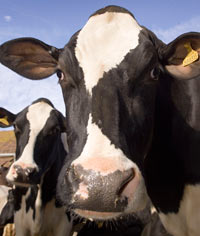Tesco monitors cow burps to cut greenhouse gases

A herd of 200 Holstein cows has been fitted with ‘burp microphones’ to assess levels of methane in cow’s diets.
The Dairy Centre for Excellence in Merseyside, Liverpool, is conducting experiments to see whether different feeds can cut methane and gas emissions.
The rumination collars, which are fitted with motion sensors, transfer information each hour by picking up stomach sounds and providing the farm’s computer with essential data on the cow’s digestion.
One cow produces between 100-200 litres of methane each day, and methane from cows accounts for the biggest proportion of global greenhouse gases, nearly 40% of all UK livestock emissions and 75% of the carbon footprint of milk production.
Junior DEFRA minister Jim Fitzpatrick said: “The dairy industry has shown what can be done in a short time, and has set a clear benchmark for all other food businesses.”
In an interview with The Sun newspaper Tesco’s community and government director, David North, added that it was vital farmers cut methane emissions.
“We hope our farm research will lead to some solutions.”
Nearly half of all dairy farmers have implemented a food and nutrition plan which will help to limit the levels of methane from their cattle.
Surveys made by Tesco show that up to 50% of their consumers want to know the carbon footprint of their food.
Along with typical nutritional information, Tesco has incorporated “carbon footprint” labels to inform their customers of these levels.
These have been introduced on more than 130 products in store, and labels were added on full fat, semi-skimmed and skimmed milk last month.
Tesco plans to cut the carbon footprint labels on over 500 of their products within the next year.
